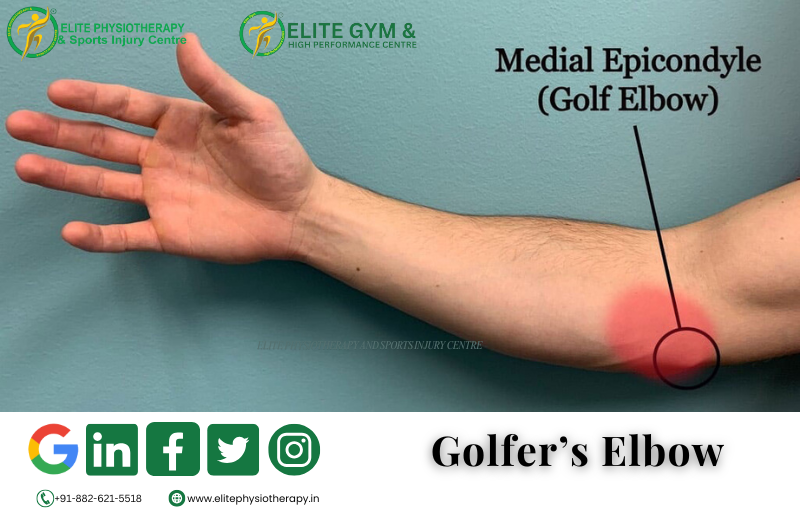What is Golfer’s Elbow?
Golfer’s elbow, often referred to as medial epicondylitis or medial epicondylalgia, is a painful ailment that affects the inside of the elbow. Overuse or repetitive stress on the forearm flexor tendons, which connect to the humerus’ medial epicondyle, is the cause of it.
It’s not just for golfers, despite its name. Anybody who engages in repetitive gripping, throwing, or wrist flexion exercises like baseball, weightlifting, or manual labor may be impacted.
Causes of Golfer’s Elbow
Repetitive microtrauma or overuse of the wrist flexor muscles and tendons is the primary cause. Additional contributing elements consist of:
- Excessive forearm pronation or wrist flexion
- Ineffective grip or poor sports skills while playing
- Weakness in the shoulder or forearm stabilizers
- Unexpected rise in workload or training intensity
- Inadequate ergonomics in routine or professional work
Clinical Features / Signs and Symptoms
Patients frequently encounter the following symptoms:
- Tenderness and pain in the inside of the elbow
- Pain that travels from the forearm to the wrist
- Pain when flexing the wrist, rotating the forearm, or gripping
- Weakness and stiffness in the hand and wrist
- Decreased strength of grip
- In severe situations, there may be warmth or edema around the elbow.
- Resisted wrist flexion or forearm pronation, like swinging a golf club or lifting objects, exacerbates the symptoms.
Diagnostic Methods and Examination
Physiotherapists evaluate functional limitations, muscle strength, and pain patterns. MRIs and ultrasounds can be used to rule out other elbow problems and confirm tendon abnormalities.
Special Physiotherapy Tests
- Resisted Wrist Flexion Test: When the elbow is extended, the patient resists wrist flexion in the Resisted Wrist Flexion Test. A favorable outcome is indicated by pain at the medial epicondyle.
- Passive Wrist Extension Test: Pain over the medial epicondyle is reproduced by extending the elbow while stretching the wrist flexors.
- Palpation: Finding the precise site of damage is aided by local soreness at the flexor-pronator origin.
Physiotherapy Management at Elite Physiotherapy and Sports Injury Centre
Our strategy at Elite Physiotherapy and Sports Injury Centre is centred on accurate diagnosis, pain management, tissue repair, and strength and function restoration. Physiotherapists tailor every treatment plan to the patient’s pain level, sport-specific needs, and job demands.
1. Pain Reduction and Inflammation Control
- Rest and Activity Modification: Steer clear of painful activities. Reintroduction occurs gradually as healing advances.
- Cryotherapy: During acute phases, ice packs or cryo-spray can assist reduce pain and inflammation.
- Bracing or Taping: Physiotherapists use counterforce elbow straps for bracing or taping to relieve tendon stress.
2. Advanced Modalities for Healing
- Shock Wave Therapy: Encourages collagen synthesis, breaks down scar tissue, and aids in tendon recovery. It facilitates the natural healing process of chronic tendon degeneration.
- The Super Inductive System (SIS): Uses electromagnetic fields to modulate pain and provide deep muscle activation. It restores muscular activation, speeds up recovery, and improves blood flow.
- High-Intensity Laser Therapy (HILT): Deep laser penetration promotes cellular healing, enhances microcirculation, and reduces inflammation for a quicker recovery using high-intensity laser therapy (HILT).
- Dry Needling: Reduces pain, increases muscle flexibility, and targets myofascial trigger points.
- Cupping Therapy: Promotes muscular relaxation, lessens stiffness, and increases local blood flow.
3. Manual Therapy and Soft Tissue Mobilization
- In order to release tense soft tissues and restore mobility, manual therapy is essential.
- Physiotherapists use techniques such as joint mobilization, deep transverse friction massage, and myofascial release to reduce adhesions and restore normal tendon gliding.
4. Strengthening and Rehabilitation Phase
- Isometric Exercises: Start with wrist flexor isometric holds that don’t hurt.
- Eccentric Loading: Controlled eccentric activities help to enhance collagen alignment and strengthen tendon fibers.
- Progressive Resistance Exercises: Physiotherapists use dumbbells, resistance bands, or grip tools to gradually increase resistance.
- Proximal Strengthening: Physiotherapists prescribe exercises for scapular and shoulder stabilizers to reduce elbow strain.
- Functional and Sports-Specific Drills: Exercises that replicate motions unique to a sport help athletes regain their peak performance.
5. Ergonomic and Technique Correction
- Our physiotherapists instruct patients on proper posture, grip methods, and equipment adjustments. Physiotherapists perform swing analysis and equipment modifications for athletes to prevent recurrence.
6. Return-to-Sport or Work Conditioning
- Physiotherapists conduct functional tests and sport-specific drills to ensure ideal strength, flexibility, and endurance before a full return to action. The purpose of maintenance programs is to stop relapses.
Conclusion
With the appropriate evaluation and individualized physical therapy, golfer’s elbow is a treatable ailment. Our evidence-based strategy at Elite Physiotherapy and Sports Injury Centre incorporates progressive exercise rehabilitation, manual therapy, and cutting-edge modalities like Shock Wave, SIS, High-Intensity Laser, Dry Needling, and Cupping.
Our objective is to help each patient recover stronger, quicker, and more resilient by restoring complete function and performance in addition to treating the pain.

